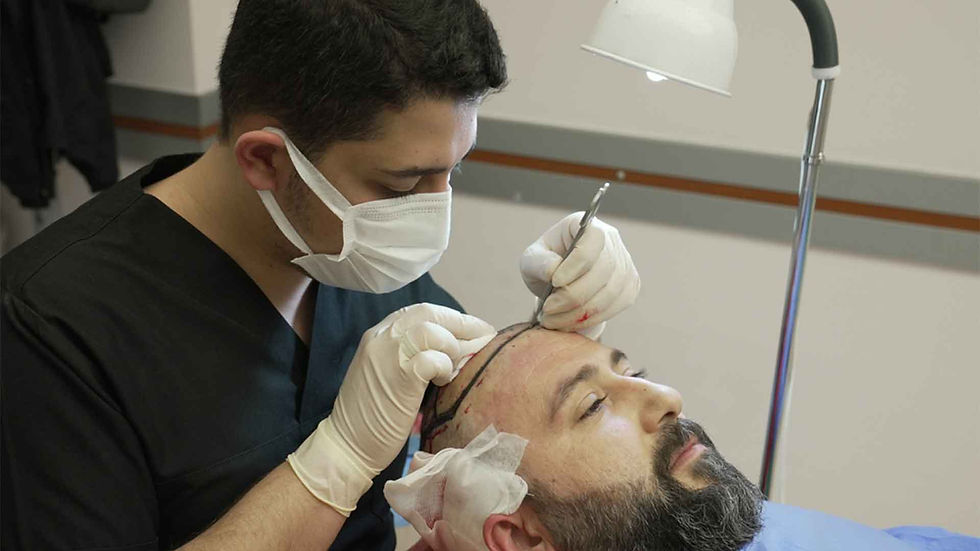How Painful Is a Hair Transplant?
- danyalmalikdynamic
- Dec 6, 2024
- 4 min read
Hair loss is a common concern for many individuals, affecting not just their appearance but their confidence as well. For those seeking a permanent solution, hair transplant treatments provided by experienced doctors are a proven option. In this article, we will explore how Hair Transplant in Dubai procedures work under the guidance of doctors and what benefits they offer.
What is Hair Transplantation?
Hair transplantation is a surgical procedure where hair follicles are removed from a donor site (usually the back or sides of the scalp) and transplanted to areas with thinning or no hair. This method allows for natural hair growth and a permanent solution to hair loss. Doctors specialize in selecting the most suitable technique based on the patient’s condition, hair type, and overall health.

Techniques Used by Doctors in Hair Transplantation
Follicular Unit Transplantation (FUT)
FUT, also known as the strip method, involves removing a strip of scalp from the donor area and dividing it into individual follicular units. These units are then carefully implanted into the thinning or balding areas of the scalp. FUT is a time-tested technique used by many doctors for patients with significant hair loss.
Follicular Unit Extraction (FUE)
FUE is a more modern technique where individual hair follicles are extracted directly from the donor area using a specialized tool. This method leaves tiny, minimally noticeable scars, making it ideal for patients seeking a less invasive treatment. FUE is especially popular for those who want to wear short hairstyles after the procedure.
Doctor’s Role in a Successful Hair Transplant Procedure
Thorough Evaluation and Consultation
The first step in any successful hair transplant treatment is a consultation with a skilled doctor. The doctor will evaluate the patient’s hair loss pattern, scalp condition, and overall health to determine the best course of action. This personalized approach ensures that the doctor selects the right technique and transplantation method to achieve the most natural-looking results.
Precision in Hair Follicle Extraction and Implantation
Hair transplant surgeries require precision and expertise. Doctors use advanced tools to extract hair follicles from the donor area without damaging the surrounding tissues. This ensures that the follicles remain healthy and viable for transplantation. The doctor then implants the follicles with careful attention to angle, direction, and density, providing natural results that blend seamlessly with the existing hair.
Post-Procedure Monitoring
After the procedure, doctors closely monitor the patient’s recovery to ensure proper healing. They provide guidance on how to care for the scalp, avoid infections, and promote hair growth. Regular follow-up appointments allow the doctor to assess the progress and address any concerns the patient may have during the healing process.
Benefits of Hair Transplantation Under Doctor’s Care
Permanent Solution to Hair Loss
Unlike temporary solutions like wigs or medications, hair transplants provide a permanent fix. The transplanted hair grows naturally and is not subject to hair loss, making it a long-lasting investment in your appearance and confidence.
Natural-Looking Results
Doctors are trained to create a hairline that is natural and complements the patient's facial features. This level of customization ensures that the transplanted hair looks undetectable, providing a more youthful and rejuvenated appearance.
Improved Confidence and Quality of Life
Hair loss can lead to a decline in self-esteem. Undergoing a hair transplant can dramatically boost your confidence, as patients experience a renewed sense of self-worth once they see the full results. This can positively affect personal and professional aspects of life.
Low Risk of Complications
When performed by a skilled doctor, hair transplant surgeries carry minimal risk of complications. The procedures are designed to be minimally invasive, with a quick recovery time and few side effects, ensuring a safe and comfortable experience for the patient.
Long-Term Benefits
Patients enjoy long-term benefits from hair transplant procedures, with the transplanted hair continuing to grow naturally. With proper care and attention, the results can last a lifetime, making the procedure a worthwhile investment.
Frequently Asked Questions
How long does it take for hair to grow after a transplant?
Hair typically begins to grow around 3 to 4 months after the procedure, with full results visible within 9 to 12 months.
Is the hair transplant procedure painful?
The procedure itself is generally painless as local anesthesia is used. Mild discomfort or soreness may occur after the procedure, but it is usually manageable.
How many sessions will I need for a hair transplant?
This depends on the extent of hair loss and the desired outcome. Some patients may need only one session, while others may require multiple procedures.
Can hair transplants be performed on other areas of the body?
Yes, hair transplants can be performed on other areas, including eyebrows, beard, and chest hair.
Is there any downtime after a hair transplant?
Patients typically experience minimal downtime and can resume normal activities within a few days, though strenuous activities should be avoided for about two weeks.
Conclusion: How Painful Is a Hair Transplant?
Hair transplant procedures are generally not very painful, as local anesthesia is used to numb the area. Post-procedure discomfort is minimal, with most patients reporting only slight soreness or tightness. With proper care and guidance from the doctor, recovery is smooth, making hair transplants a relatively comfortable and effective solution for hair restoration.
Comments